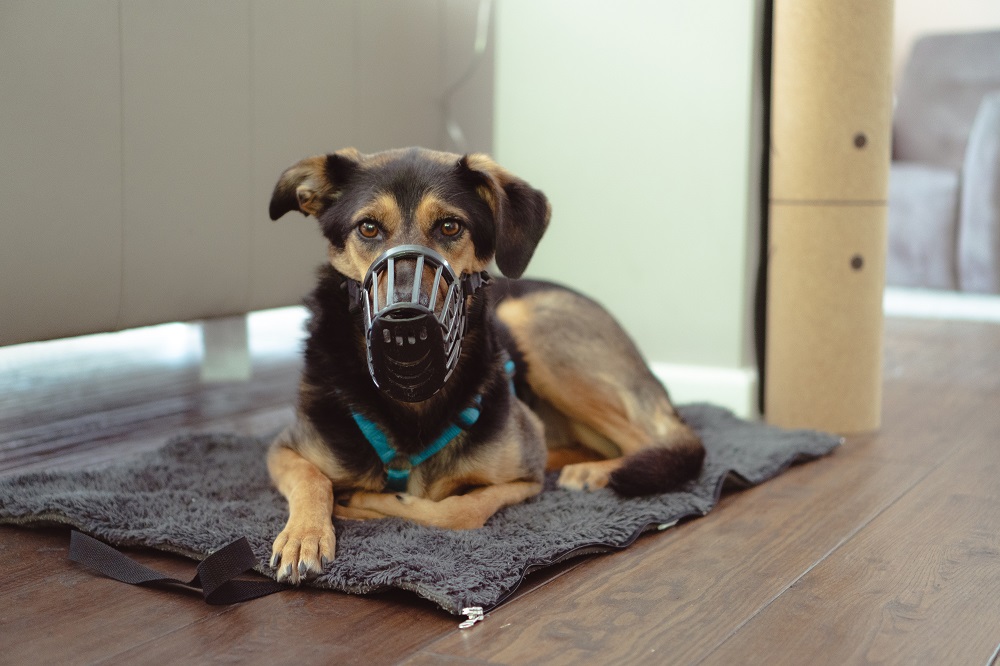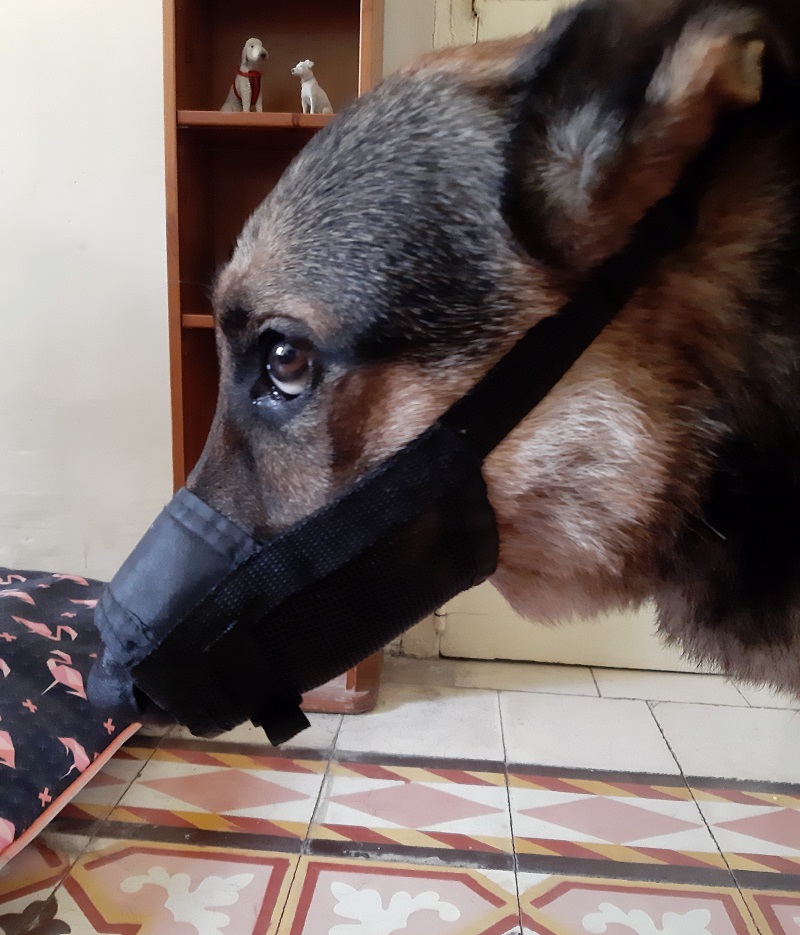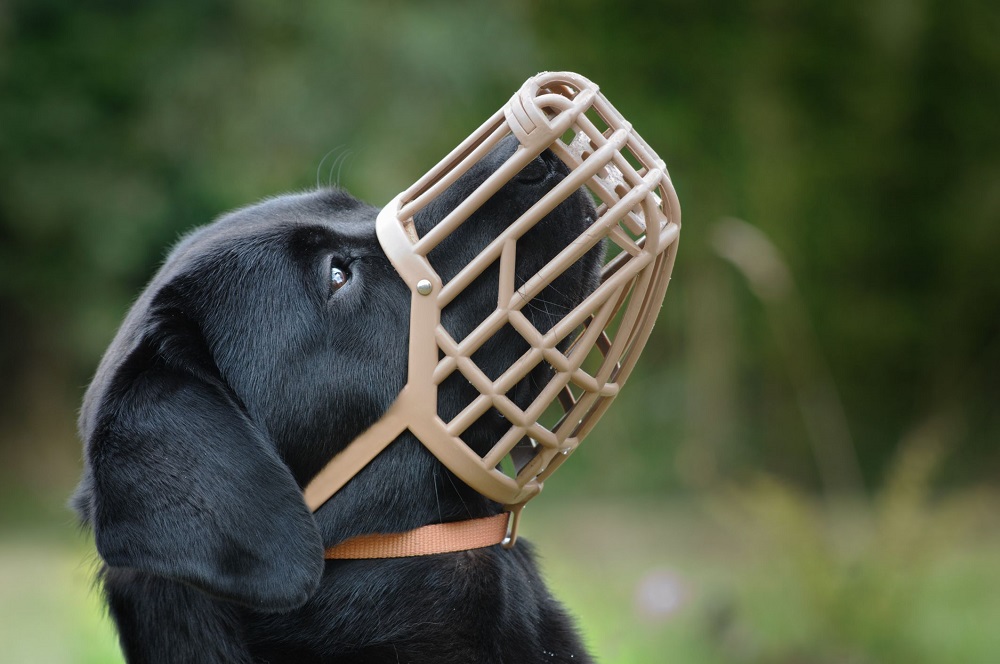A dog muzzle is an essential piece of dog owning equipment. They have many uses and are always worth having in with the rest of your dog care and grooming arsenal. But many people use them incorrectly or use the wrong type of muzzle for the wrong purpose.
In this article we will look at the various types of muzzles for dogs, which one to use and what each type has been designed for.

Why do dogs need muzzles?
Muzzles are useful for many things.
- Dogs who may bite
- Dogs who scavenge
- Temporary emergency use
The most commonly understood use of a dog muzzle is for dogs who bite or tend towards aggression or snapping. This is not cruel and the wearing of the muzzle won’t harm the dog. In fact, it is doing the opposite. It is keeping all dogs safe from injury, whether it is to safeguard the dog wearing the muzzle or to protect any dogs they encounter.
Muzzles can also be incredibly useful if you have a dog who picks up or eats every bit of food or rubbish they encounter on their walks. For their own safety, you need to stop this from happening. Scavenging can be dangerous for the dog and therefore stressful for the owner. All sorts of dangerous things can be picked up by a scavenging dog on even the shortest walk. If your dog tends to scavenge, it is better to be safe than sorry. Pop a muzzle on them that will stop them ingesting everything they come across.
Finally, there is the temporary use type of dog muzzle. These are often seen in use at the vets because they are useful if a dog is nervous and might snap in fear. Vets might use a temporary muzzle when giving dogs an injection, inspecting an injury etc.. They are also useful to have in your medical box at home for emergencies or if your dog gets fearful when you cut their nails and so on.
What are the different types of dog muzzle?
Typically on walks, you may see a dog wearing what is known as a basket muzzle. These are either wire, leather or plastic and are a basket-type shape, hence the name. Because this type of muzzle is an open and roomy design, the dog won’t be able to bite but will still be able to breathe, pant and even drink normally. Wearing a muzzle may take a little getting used to but after a while a well-fitting basket muzzle is well tolerated by most dogs.
Some basket dog muzzles for biting prevention include a strap that goes over the top of the head as well as the standard back of head / neck strap. This is to stop the muzzle coming off accidentally on walks, when pawed at or in a tussle and can be very useful.
A classic basket muzzle is mostly designed to stop a dog from biting but some plastic basket muzzles also have an extra portcullis type attachment that goes into front nose the end of the muzzle to stop the dog from being able to pick up even the smallest pieces or food or rubbish. This is perfect for a dog who is a scavenger. The extra detachable grill slots into the front of the muzzle, making the grid openings even smaller so even errant tongues won’t be able to poke out.
Flatter faced dogs need a special design of basket muzzle as they don’t have the long snouts of other breeds. You can get specially designed muzzles for short nosed, flat faced dogs. For comfort, these are often a durable fabric with breathable mesh face/front design.
The temporary use or emergency muzzle looks very different. They are usually fabric or mesh and they fit very snuggly around the dog’s snout, restricting any opening of the mouth. They can be put on the dog quickly and they stop biting or any movement of the dog’s mouth. This type of muzzle is not comfortable for the dog to wear and they can’t pant or drink when wearing one. This type of muzzle should therefore only be used for short periods of time (max 5 minutes) when a specific need arises for its use like nail cutting or veterinary use. You must NEVER walk your dog in one of these tight fitting muzzles. That would be incredibly dangerous and cruel. To stop your dog biting or scavenging on a walk, only ever use a roomy basket muzzle.

Getting a good fit
A basket muzzle should allow the dog to open their mouth and pant normally. It should sit comfortable with plenty of room around the inside so it is not touching their face too much, has plenty of room at the nose end and is not sitting too close to their eyes. If it is too high up the dog’s face, close to their eyes, loosen the neck strap a little. Once in place, check that the muzzle is securely on by gently pulling it away from your dog’s face. It should be able to be pulled a little but not come off.
A temporary use or emergency muzzle is different in that is should fit very closely to the snout, closing the mouth completely. As before, adjust the strap so that the muzzle won’t be easily pulled or pawed off but not so tight that it is too near the dog’s eyes. Once it is on, check that the dog’s mouth is properly closed. If the mouth can still be opened, adjust the width of the muzzle itself. A good brand/make will have an adjustable strap or other type of adjustment point not just around the head strap but also around the width of the muzzle, enabling you to get the perfect snout fit.
Getting dogs used to wearing a muzzle
Not many dogs will just stand there and let someone put something strange over their face. That is a pretty scary prospect. So start muzzle wearing practice slowly and kindly at home. Don’t expect to get a muzzle on your dog and go straight out for a walk on day one. The chances are your dog will back away, paw at their face and generally try to get it off or refuse to walk.
Throughout the day for a few days or until your dog is happy, put the muzzle near their face and treat and praise them. This way they begin to see that the muzzle is not going to harm them and in fact gets them rewards. Slowly progress to putting more of the muzzle onto your dog’s face and finally to doing it up. Encourage your dog every step of the way. Good dog!
Does my dog need to wear a muzzle?
If your dog bites or has shown signs of aggression, even fear aggression, then yes… your dog should wear a muzzle in public or when around other dogs. Even if your dog is on lead and you are therefore in control of who your dog meets, your dog should be muzzled. Why? You can’t ever be in control of other dogs who may be off lead and may approach your dog, unless you are on private property of course. If your dog bites or injures another dog, who was on or off lead won’t matter.
If your dog scavenges, I would say yes again, unless you can have your eyes on your dog 100% of the time and can quickly intervene when they go for a ‘prize’. One of my friends had a dog who ate some slug/snail bait on a walk and sadly her dog died as a result. It is not worth the risk.
Muzzle preconceptions
My German Shepherd quite often wears a muzzle. She is an awful scavenger. If I need to walk her past a lot of rubbish, popping her muzzle on her is a lot easier than trying to drag a GSD and captured bin bag along the pavement. She is also a poop eater so if an area is poop riddled, her muzzle goes on or she will eat the lot. Yes, disgusting I know which is why I stop her with the use of her basket muzzle and scavenger attachment.

So why are dog muzzles feared rather than revered? If I walk my GSD bare faced, she gets admiring glances as she is a very handsome girl. Walk her with a muzzle though and she gets scowled at. Heads start shaking and people have even stopped me to ask why I am doing that to her. Rather strange reactions when you think about it. Whatever the reason for the wearing the muzzle, a dog in a muzzle clearly has a very sensible owner who is making sure their dog doesn’t do themselves or other dogs any harm. So why all the scowling and head shaking?
Next time you see a dog wearing a muzzle, remember that the owner is very sensibly taking precautions. Their dog could be wearing the muzzle for any number of reasons. So give them a smile, maybe even a thumbs up and let’s remove the stigma of the dog muzzle.
Hopefully this article has helped you to see the various uses of a dog muzzle and has also helped you to choose one that suits your dog and their needs.
For more helpful advice and a great rang of dog products, visit D for Dog.
Author Jenny Prevel, Owner D for Dog https://www.dfordog.co.uk
Jenny Prevel is a lifelong animal lover and dog owner. She grew up with dogs, cats, pigs, chickens and rabbits, to name a few. Wanting to help dogs in her adult life, Jenny started adopting needy rescue dogs in 2003. After adopting a deaf dog and wanting to share what she had learnt, Jenny started her website D for Dog in 2004 and has helped many dog owners by writing articles on a number of topics including pet loss and end of life, dog adoption, dog care and health issues.
Jenny shares her life with her husband Paul and their three-legged German Shepherd Zena who they adopted as a neglect case.
